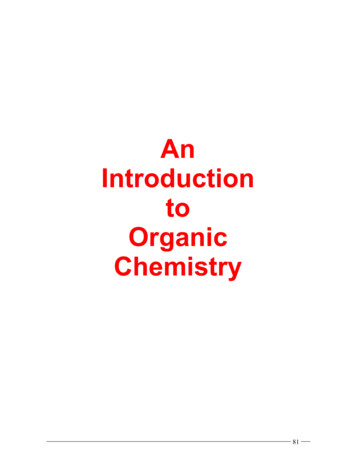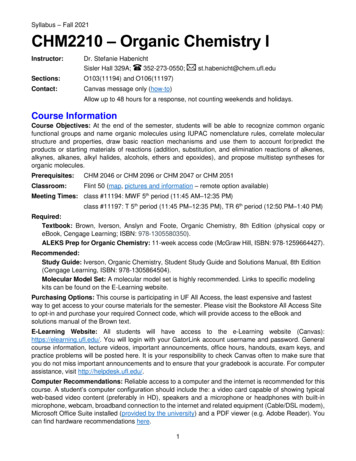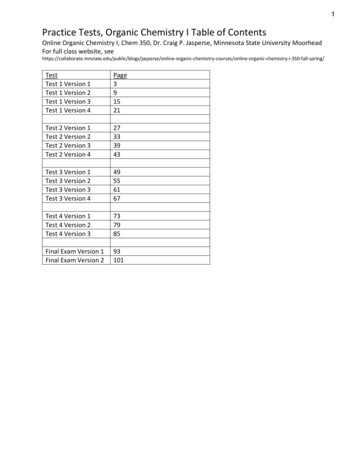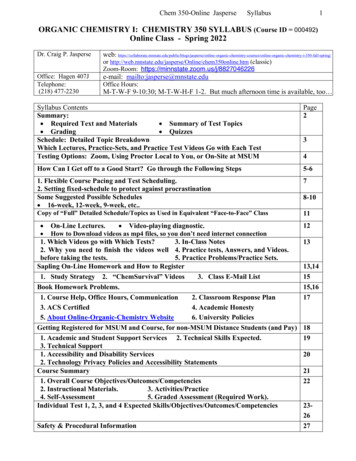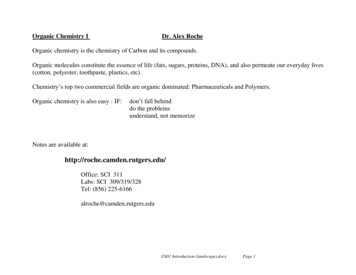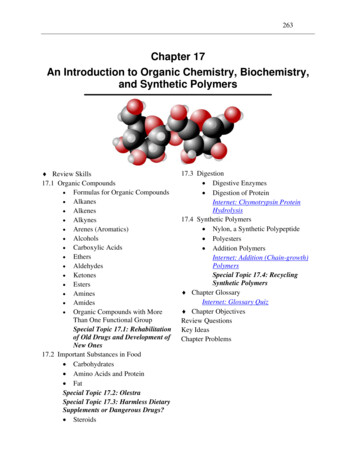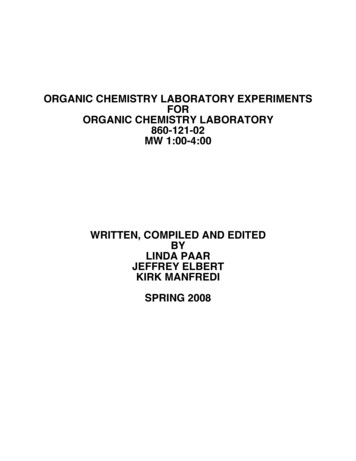
Transcription
ORGANIC CHEMISTRY LABORATORY EXPERIMENTSFORORGANIC CHEMISTRY LABORATORY860-121-02MW 1:00-4:00WRITTEN, COMPILED AND EDITEDBYLINDA PAARJEFFREY ELBERTKIRK MANFREDISPRING 2008
TABLE OF CONTENTSSYNTHESIS OF ASPIRIN1MELTING POINT AND CRYSTALLIZATION2DISTILLATION8EXTRACTION11TLC AND CHROMATOGRAPHY14NATURAL PRODUCTS: ISOLATION OF LIMONENE23FREE RADICAL CHLORINATION24SN1 AND SN2 REACTIONS27DEHYDRATION REACTIONS30GRIGNARD SYNTHESIS32COMPUTATIONAL CHEMISTRY36MULTIPLE STEP SYNTHESIS38
ORGANIC CHEMISTRY 121EXPERIMENT 1SYNTHESIS OF ASPIRIN FROM SALICYLIC ACIDAspirin is one of the oldest and most common drugs in use today.It is both an analgesic (pain killer) and antipyretic (reducesfever). One method of preparation is to react salicylic acid (1 )with acetic anhydride (2) and a trace amount of acid (equation 1).OCH3OHCOOHCOOH 1O(CH3CO)2O2H 3CH3COOH4The chemical name for aspirin is acetylsalicylic acid (3)PROCEDUREPlace 3.00 g of salicylic acid in a 125 ml Erlenmeyer flask.Cautiously add 6 ml of acetic anhydride and then 5 drops ofconcentrated H2SO4. Mix the reagents and heat the flask in abeaker of water warmed to 80-90 C, for 10 minutes. Remove theErlenmeyer flask and allow it to cool to room temperature. Add 40ml of H2O and let the sample crystallize in an ice-water bath.*Filter and wash the crystals with cold water. Allow them to airdry overnight and weigh the product. What is the percent yield?One drawback to this synthetic procedure is that there is thepossibility of some left over salicylic acid. To test forunreacted salicylic acid, add a few drops of 1% ferric chloridesolution to a tube containing a few mg of salicylic acid dissolvedin water. What do you observe? Do the same for a few mg of yoursample dissolved in water. Is there any salicylic acid?Write-Up: As soon as you are finished write this lab report inyour notebook as a "normal" lab write-up and hand it in. You willalso need to draw and label the chemical reaction using thesoftware available on the CNS network. Staple or tape this in yourwrite-up.* A problem with this procedure is that very often crystals do notinitially form. One gets a viscous oil that will eventuallysolidify. If you get an oil, stir it with a glass rod while it isin the ice bath. For the best results make sure that the glass rodis "scratching" the flask's surface.1
MELTING POINTS AND SUBLIMATIONMELTING POINTThe temperature range at which a crystalline solid changes into a liquid is defined asthe melting point. To obtain the melting point of a compound, a small sample is slowlyheated. The sample is carefully observed (usually through a small tube) and thetemperature at which liquid is first observed is noted. When all of the solid has liquified,this temperature is noted as well. In most instances a sample will melt over a smallrange of temperature. Thus the temperature at which the liquid is first observed and thesolid is totally liquified is referred to as the melting point range. Most pure samplesmelt over a very small ( 1 ) temperature range while some samples may melt over acouple of degrees. In general, samples that melt over a broad range ( 5 ) probablyhave soluble impurities which depress the melting point. Consequently, the meltingpoint range of a compound can be an indication of purity.SUBLIMATIONSublimation is a process by which a compound goes from a solid to a gas without goingthrough a liquid phase. Most of you have observed this process when you have seen“dry ice” (CO2(s)) or “freeze dried” a substance. Many organic compounds “sublime” atreadily accessible temperatures and pressures which gives us a route to a simple andquick purification.PROCEDURE(Since we only have a limited number of melting point apparatuses, some of you shoulddo the sublimation first and melting point second.)1) Melting pointA) Obtain a small sample of cinnamic acid or urea and obtain its melting point range.Repeat the process with another sample. Compare the melting point you recorded tothe melting point in the literature.B) Take a “mixed melting point” of one of the cinnamic acid / urea mixtures provided.What do you observe?2) SublimationObtain a 50 mg sample of salicylic acid and place it into the side arm Erlenmeyer flaskfrom your microscale kit. Assemble the apparatus as depicted on page 212 of Zubrick orshown in the lab demo. Fill the centrifuge tube with ice. Heat the flask gently on aheating mantel. You should observe the solid evaporating into “whiffs” of gas andcondensing as a solid on the cold surface of the centrifuge tube. (This is often referredto as a “cold finger”)Carefully disassemble the apparatus so as not to dislodge any solid on the cold finger.Scrape the solid off the cold finger and weigh it. Calculate the % recovery.2
Compound Purification: RecrystallizationPurification of compounds that are either synthesized in the lab or that have beenisolated from sources in nature is a very important part of organic chemistry. A varietyof methods may be used including distillation, sublimation, extraction, different kinds ofchromatography and recrystallization. The basic process of recrystallization involvesdissolving the substance in a solvent to remove insoluble impurities then letting thedesired compound crystallize.Products obtained from an organic reaction are seldom pure when isolateddirectly from the reaction mixture. If the product is solid, it may be purified byrecrystallization from a suitable solvent. A good recrystallization solvent should dissolvea moderate quantity of the substance to be purified at elevated temperatures but only asmall quantity of the substance at lower temperature. It should dissolve impuritiesreadily at low temperatures or not at all. Finally, the solvent should be readily removedfrom the purified product. This usually means that it has a relatively low boiling point.A chemist can consult the literature for information regarding recrystallizing solvents fora particular substance, or if that information is not available, test several solvents. Asmall amount of the substance to be recrystallized is placed in several test tubes and asmall amount of a different solvent is added to each. Solubility is then noted both at coldand elevated temperatures. The quality and quantity of crystals obtained when thesolution is cooled are also noted. To get a good yield of purified material, the minimumamount of hot solvent to dissolve all the impure material is used. In practice 3-5% moresolvent than necessary is used so the solution is not saturated. If the impure compoundcontains traces of colored material that are not native to the compound, they may beremoved by adding a small amount of decolorizing charcoal to the hot solution, quicklyfiltering it and allowing it to crystallize. Usually crystallization spontaneously occursupon cooling the solution. If it does not, crystallization may be induced by cooling thesolution in an ice bath, scratching the vessel wall with a glass stirring rod or by adding asingle crystal of pure material (a seed crystal). The crystals are then isolated usingvacuum filtration. The collected crystals are then washed with ice cold solvent to furtherremove impurities.ProcedureSolubility TestsPlace about 10 mg of anthracene into each of 4 reaction tubes or micro test tubes.Weigh out the 10 mg quantity until you are familiar with the appearance (size) ofapproximately 10 mg of sample. Once familiar with 10 mg as a small pile on the end ofyour spatula, you may estimate the amount and not weigh it out. Add 0.25 mL of ethanolto tube 1 and observe the mixture. Repeat with water (tube 2), toluene (tube 3), andligroin (tube 4). The sample is considered dissolved when the solution is clear with nocloudiness or solid apparent. A solution of dissolved solute may have color; it is stillconsidered dissolved if no solid is apparent. If you observe any solid on the bottom ofthe tube, floating on the top of the solvent, or dispersed in the solvent (cloudy), thesample is considered not to have dissolved.If the samples dissolve in a solvent at room temperature, you do not need to heatthe sample in the next step. If the sample readily dissolves in ethanol at room3
temperature, add one or two drops of water to see if cloudiness (precipitate) forms.Continue adding one or two drops of water and checking for precipitation until you haveadded 10 drops total.For those samples which did not dissolve in a solvent at room temperature, gentlyheat the mixture on the steam bath and observe if the sample dissolves in hot solvent.Pay particular attention to the ligroin mixtures. Ligroin has a low boiling point and canbe easily boiled away completely. If you boil away a solvent, simply add the 0.25 mLagain and continue.Repeat the experiment with [4-amino-1-naphthalenesulfonic acid, sodium salt]and then again with benzoic acid.Record your observations in your notebook. Did the sample dissolve in a solventat room temperature? Did the sample dissolve in hot solvent? Did the sample precipitate(crystallize) upon cooling of the solvent? Recording this data in table form works best.Microscale Recrystallization of acetylsalicylic acid from water.Calculate the required minimum volume of hot water to dissolve 60 mg ofacetylsalicylic acid. The solubility of acetylsalicylic acid in 25 C water is 1.0g/300 mL.The solubility of acetylsalicylic acid in 37 C water is 1.0g/100 mL. Aspirin willhydrolyze in boiling water, so do not heat the recrystallization solution very long. Heatuntil you just see thermal gradients (wavy heat lines) or bubbles begin to form. Use theaspirin solubility at 37 C for your hot solubility calculation and reduce the solventvolume by 1/3 to 1/2 (we are guessing at the higher solubility of aspirin in 100 Cwater).Place the 60 mg of acetylsalicylic acid in a reaction tube and add the requiredminimum volume of water calculated above. Add a boiling stick and begin gentlyheating on the sand bath. As the solvent begins to boil (see above), add water dropwiseuntil the sample just dissolves. Add 1 more drop of water. Record the total volume ofwater needed to dissolve the sample (21 drops 1 mL) Remove the solution from theheat and place in the test tube holder to cool to room temperature undisturbed.If crystals have not formed upon cooling, scratch the side of the reaction tube witha glass stir rod. If crystals still do not form, ask your instructor for help on the next stepsto take.Once crystals have formed, place the reaction tube in an ice bath and allow crystallizationto complete. Once the reaction tube is ice cold and no further crystallization is occurring,proceed with the following isolation steps.Place the tip of your Pasteur pipette firmly on the bottom of the reaction tube.Not so firmly as to break the pipette stem. Draw the solvent away from the crystalsleaving as many crystals as possible. There should be very few crystals in your pipettestem. If too many crystals enter the pipette, use the vacuum filtration apparatus with theHirsch funnel to isolate your crystals. The Hirsch funnel and vacuum is also a good wayto pre-dry your crystals.Complete the drying of the crystals by attaching the reaction tube containing thecrystals to an aspirator apparatus set up gently heating over a steam bath while thecrystals are under vacuum. All visible solvent must be removed before using theaspirator drying technique. Remove the crystals from the reaction tube by scraping with aUUUU4
spatula and complete the drying in the lab drying oven if necessary. Weigh the drycrystals. Obtain a melting point of dry crystals and of the crude starting mixture.Recrystallization of naphthalene from 80% methanol/waterRecrystallize naphthalene (40 mg) from the mixed solvent 80% methanol/water.You will not calculate the minimum volume of solvent needed for this experiment,therefore you will measure it as the experiment proceeds.Place 40 mg of naphthalene in a reaction tube and add 5-10 drops of the mixedsolvent, just enough to cover the crystals. Add a boiling stick and begin gently heatingover the steam bath. Add solvent dropwise as the mixture warms to boiling. Themethanol is relatively low boiling, so it will be easy to boil off your solvent if you heattoo strongly, pay attention and heat gently. Once all of the crystals have dissolved, addone more drop of solvent and remove from the heat. Record the total volume of solventused (21 drops 1 mL). Place the reaction tube in a test tube stand and allow to cool toroom temp undisturbed. Follow the normal procedure if crystal growth does not occur.Once crystals are observed, place the reaction tube in an ice bath and allowcrystallization to complete. Remove the solvent by pipette as previously described.Scrape the crystals onto filter paper and allow them to air dry for 10-15 minutes. Do notheat the crystals as naphthalene will sublime. Do not dry the crystals in the drying ovenfor the same reason. Do not air dry naphthalene for prolonged periods (days) or you willlose your product to sublimation. If you need to store naphthalene, do so in a screw topvial to prevent product loss. Once the naphthalene is dry, weigh the crystals anddetermine the melting point.UURecrystallization of an UnknownDissolving the impure substance.Measure the solubility properties of your unknown using 10 mg samples andwater, ethanol, and methanol. Determine the appropriate solvent to recrystallize yourunknown. Keep in mind that your unknown will have insoluble impurities. Not allmaterial will dissolve. Look for differently colored material that does not dissolve. Thisis insoluble impurity and does not affect your decision of the appropriate solvent forrecrystallization.Accurately weigh out approximately 1.0 g of impure unknown. Place your unknown in a50-125 mL Erlenmeyer flask and add your chosen solvent dropwise until the crystals arejust covered with solvent. Begin heating using a hot plate until the solvent is boilinggently. Add solvent dropwise until the crystals dissolve. Insoluble impurties will notdissolve. These impurities may have a different color or different crystal type than yourunknown which makes up the bulk of the crystals. Once the crystals have just dissolved,add 5% more solvent. Record the total volume of solvent used (21 drops 1 mL).Remove the insoluble impuritiesFilter the hot solution by gravity filtration using fluted filter paper and theapparatus described in chapter 13 of your techniques. The plastic funnel should beheated on your steam bath until just before use. Hot solvent should be available at thistime. The receiving Erlenmeyer flask should also be heated either on the steam bath or5
hot plate (add a small amount of solvent to the flask if you use the hot plate). Place thefluted filter paper into the hot plastic funnel. Place the filter paper and funnel onto theheated receiving Erlenmeyer flask which should be setting on a ceramic disk just prior touse. Poor the hot recrystallization mixture as quickly as possible into the fluted filterpaper. Use a clamp (burette or universal), paper towel ring, or other suitable means toavoid burning your fingers as you poor the hot solution. Allow the solution to drainthrough the paper. Poor a small volume (no more than 1-2 mLs) of hot solvent throughthe paper to dissolve any crystals that have precipitated in the paper or funnel.Cooling the solutionCool the solution to room temperature and then place the flask in ice water. Donot rush this process as the material may form very small crystals that are difficult tocollect or form an oil in the recrystallizing solvent instead of crystals. Follow the normalprocedure if crystal growth is not observed upon cooling.Collect the crystalsWhen it doesn't appear that any more crystals are forming, wait 5 more minutesand then collect the crystals using a vacuum filter apparatus. Swirl the flask to suspendthe crystals and then pour the slurry into the funnel (make sure that the vacuum is going!)Wash the crystals with a very small amount of ice cold solvent. The liquid that is in thevacuum flask is referred to as the mother liquor. Allow the crystals to dry with thevacuum on for several minutes. During this time, crystals may be observed forming inthe mother liquor. These crystals are known as the second crop of crystals and areusually formed as the solvent in the vacuum flask evaporates and gets colder. Additionalcrops of crystals may form depending on the substance and solvent. We will not becollecting second crops of crystals. Estimate the amount. You will need to refer to thisamount in your conclusion section when discussing potential points of loss in theexperiment. Dry the crystals in the oven unless otherwise instructed by the lab staff.After the crystals are dry, determine the final weight.Determine the melting point of your unknown and consult the charts on thebulletin board to identify your unknown. A mixed melting point would be appropriate atthis time to confirm your identification, but we will not do this to save time and materials.Pre-Lab Questions1. What is the purpose of recrystallization?2. What properties should a solvent have to be a good recrystallization solvent for aparticular compound? Under what conditions is a mixed solvent appropriate?3. Why is vacuum filtration preferred to gravity filtration for product isolation in arecrystallization? Why is gravity filtration, and not vacuum filtration, used to filtersuspended (insoluble) impurities during hot filtration?6
4. Assuming that sand and sodium chloride were the impurities in a sample ofacetanilide, tell whether each was a soluble or insoluble impurity in the solvent system(water) and describe how each was removed from the acetanilide during recrystallization.5. A sample of naphthalene (white when pure) was found to be grayish after a completerecrystallization (no steps omitted). What accounts for the gray color?6. What is the purpose of fluting filter paper?7. Why are stemless funnels preferred for hot filtrations?7
Distillation ExperimentDistillation is the most common method used to separate and purify liquids. Theprocess consists of heating a liquid to its boiling point and conducting the vapors to acooling device where they are condensed. The condensate is then collected.The vapor pressure of a liquid is defined as the pressure that is exerted by a liquidat a given temperature. This force is due to the molecules escaping from the liquid’ssurface into the gas phase. The vapor pressure of a liquid increases with increasingtemperature. The boiling point of a liquid is that temperature at which the vapor pressureis equal to the pressure of the surroundings. If a flask is open to the air, the vaporpressure at the boiling point is equal to the atmospheric pressure. The boiling points ofmany liquids are listed in the literature referenced to 760 mm Hg (standard pressure).The boiling point of a liquid at a different pressure can then be determined by using aPressure-Temperature Alignment Chart.The boiling point of a liquid is determined by placing a thermometer in the vapor.The temperature of the vapor will remain constant throughout the distillation if the vaporis pure. The boiling point at a given pressure is a characteristic property of the purecompound just as the melting point of a pure crystalline compound.If a mixture of two miscible liquids with different boiling points is heated toboiling, the vapor will not have the same composition as the liquid; it will be richer in themore volatile component. In order to obtain pure components, the now enriched mixturemust be redistilled. Each successive distillation results in a purer distillate of the lowerboiling component until the pure component is obtained. A fractionating column is adevice for increasing the efficiency of the distillation process. It consists of a verticalcolumn packed with inert materials or with indentations which increase the surface areaof the column. As the hot vapors of the liquid rise, they condense on the greater surfacearea. As the condensate flows back down to the boiling flask, the liquid is revaporized asit comes in contact with the hotter portion of the lower column. This is repeated manytimes, until the final distillate is nearly pure. By using select columns, liquids withboiling points just 2 C apart can be separated.Some liquid mixtures do not form nearly ideal solutions (as described in thepreceding section), but instead form a constant boiling solution that is a constant mixtureof components. This is known as an azeotrope. An example of an azeotrope is water andethanol. A solution of 95.6% ethanol and 4.4% water will boil at 78.2 C and thedistillate will have the same composition. The boiling point of the azeotrope is lowerthan ethanol (78.3 C) or water ( 100 C).In this experiment you will separate a nearly ideal solution of cyclohexane (bp81 C) and toluene (bp 111 C) using simple and fractional distillations. In addition youwill do the experiments using the “traditional” glassware and using microscale glassware.Caution!!! No Open FlamesProcedureSet up the simple distillation apparatus shown in the figures, using a 100 ml roundbottom flask if available (use a larger flask if necessary). Very lightly lubricating theground glass joints with silicone grease is recommended. Pay particular attention to the8
placement of clamps in the figures. Also pay attention to the placement of thethermometer in the figures. Proper thermometer placement is critical to accuratetemperature readings. Remember, water goes in the lower end of the condensing columnand out the higher end. Use rubber bands to secure all of the pieces together, also shownin the figures. The greased joints will tend to slide apart if not secured together. Haveyour instructor check the apparatus before starting. Be sure to add a boiling chip beforeheating the solvents. Add 30 mL of cyclohexane and 30 mL of toluene to yourdistillation flask. Heat the round bottom with the heating mantel until the distillate dropsat a regular rate of approximately 1 drop per second. Collect distillate in a graduatedcylinder. Record the temperature as the distillate starts to collect in the graduatedcylinder. After 3 drops have distilled over, collect into a small vial three drops of thedistillate. This is your GC sample “First Drops – Simple”. Record the temperature every2 ml as the distillation proceeds. Stop the distillation when there is still a small amountof liquid in the flask (approximately 50 ml collected in the graduated cylinder). Neverdistill to dryness! Collect three drops into a second small vial just before turning off theheat. This is your GC sample “Last Drops – Simple”. Submit the GC samples foranalysis.Allow the apparatus to cool until it is comfortable to handle. Add thefractionating column to the simple distillation apparatus and adjust the clamping asshown in the fractional distillation apparatus figure. The fractionating column is acondenser column filled with stainless steel sponge. Reuse the cyclohexane and toluenefrom the simple distillation, simply pour it from your graduated cylinder back into theboiling flask. (Do not discard the pot residue.) Add fresh boiling chips. Repeat thedistillation experiment as outlined above, recording temperatures every 2 mL of collecteddistillate. Collect First (after several drops have run through and the column has been“rinsed”) and Last drops of the Fractional distillation experiment as described for theSimple experiment. (Be sure to allow 3 drops to pass through the column beforecollecting the first GC sample.) Submit the samples “First Drops – Frac” and “LastDrops – Frac” for analysis.Graph your results. Volume of distillate on the x-axis and temperature recordedon the y-axis. Compare the curves in your conclusions.Set up the microscale simple distillation apparatus as shown in the figure. Addtwo mL of cyclohexane and two mLs of toluene along with a boiling chip to the boilingflask. Heat with a sand bath (do not elevate the sand bath) until the distillate drops at arate of 1 drop every 5 seconds. Heating using a sand bath is best controlled by movingsand toward (more heat) and away (less heat) from your boiling flask. Set the Powermiteswitch at approximately 5 and use a spatula to move sand for fine heating control.Monitoring the volume collected during the microscale fractional distillation is best doneby counting drops. Record a temperature every two or three drops.Repeat the process above using a microscale fractional distillation apparatus. Forthis experiment be sure to add fresh boiling ships and use new cyclohexane and toluene(2 mLs of each).UUUUGraph your results. Volume of distillate on the x-axis and temperature recorded on the yaxis. Compare the curves in your conclusions.9
Questions1. What is the purpose of the boiling chips?2. If ideal liquids x and y both have a boiling point of 110 C, what will be the boilingpoint of a mixture of x and y? Can you separate the two liquids by distillation? Howdoes this limit the value of boiling points as a criteria for determining the purity ofliquids?3.There is a 63 difference in boiling points between heptane and pentane. What isthis difference attributed to?4. What effect is produced on the boiling point of a solution by a soluble, non-volatilesubstance? What is the effect produced on the boiling point of a liquid by an insolublesubstance? What is the vapor temperature above the surfaces of these to liquids?5. Why doesn’t a pure liquid distill all at once when the boiling point is reached?6. Why is a packed column more efficient than an unpacked column for fractionaldistillation?7. Why does slow distillation result in better separation of two liquids than fastdistillation?8. Why is it dangerous to attempt a distillation in a completely closed system?10
ExtractionSeparation of a Three Component Mixture Using Extraction TechniquesExtraction is a method often used by organic chemists for the rapid crude separation ofmixtures containing acidic and/or basic compounds often in the presence of neutralmaterials. The separation uses acid-base chemistry and two mutually insoluble layers ofsolvent (water and t-butylmethylether).You will be separating 3 compounds: benzoic acid, 2-naphthol, and p-dimethoxybenzene.OCH3OOHOHbenzoic acid2-naphtholOCH3p-dimethoxybenzeneDetermination of a Partition CoefficientIn this experiment, you will extract a dichloromethane solution of benzoic acid withwater. Subsequent evaporation of the CH2Cl2 layer, and recovery of the remainingbenzoic acid will allow you to calculate the partition coefficient of benzoic acid inCH2Cl2/water.Weigh out 100 mg of benzoic acid and dissolve it in a reaction tube containing 1.6mL CH2Cl2. Add 1.6 mL distilled water and mix thoroughly. You may do this bydrawing 1/2 of your solution into your pipette and expelling it into the remainingsolution in the reaction tube several times. Alternatively, you may shake the tube aftersealing with a sleeve stopper. Set the tube aside and allow the layers to separate.Remove the aqueous layer without removing any organic layer. This requires carefulpipette skills. Add anhydrous CaCl2 to the CH2Cl2 layer until you do not observe anyfurther clumping of the pellets. Water in the organic layer adsorbs to the pellets, partiallydissolving the outer material and causing them to stick together, this is called clumping.You should flick the reaction tube to promote mixing. Do not shake so vigorously thatyou break the pellets. After 5 minutes of drying time, remove the organic layer by pipetteand place in a clean, dry, pre-weighed 10 mL Erlenmeyer flask with a boiling chip. Theflask and chip must be pre-weighed. Rinse the pellets twice with about 1 mL freshCH2Cl2 and add these rinses to the Erlenmeyer flask. Evaporate the solvent on a steambath in the hood to dryness. Weigh the flask with boiling chip and benzoic acid. Use thismass to determine the partition coefficient.Macroscale Extraction of 3 Component System (Acidic and Neutral)It is critical that you have prepared a flow chart of the extraction sequence beforebeginning the experiment. These extractions rely on acid/base chemistry that you havestudied in Gen Chem and Org I. Find the pKa’s of the compounds and determine thereactions that will occur with the bases used in this experiment. Complete the flow chartoutline at the end of the this lab.11
Obtain a pre-mixed sample of equal parts benzoic acid, 2-naphthol, and pdimethoxybenzene. Weigh the sample. Dissolve the sample in a 100 mL beaker with 30mL of t-butyl methyl ether. Transfer the ether solution to a 250 mL separatory funneland rinse the beaker with about 10 mL ether to complete the transfer.Add 10 mL of water to the separatory funnel and note which layer is organic and which isaqueous. Add 10 mL of saturated sodium bicarbonate solution to the separatory funnel.Shake the funnel as depicted on page 121 of Zubrick or the figure below. Be sure to ventseveral times during the shaking to relieve pressure. Place the separatory funnel back onthe iron ring, with the stopcock closed, and remove the stopper. Allow the layers toseparate. You want to remove the aqueous layer, which in this case is the lower layer.Drain the aqueous layer into the labeled flask (A). Repeat the sodium bicarbonateextraction with 10 mL fresh solution, draining the aqueous layer into flask A to combinethe two aqueous extractions.The separatory funnel should contain the organic layer at this point. The first,bicarbonate, extraction aqueous layer should be combined in flask A. Now repeat theextraction sequence as described above, using 10 mL of 1.5 M NaOH. As described forthe first extraction, you will extract twice with NaOH, combining the aqueous layers inflask B. Add 5 mL of distilled water, shake, and add the aqueous layer to flask B. Add15 mL of saturated NaCl solution and shake. Drain the lower, aqueous layer and discard.This is a coarse drying step for
ORGANIC CHEMISTRY LABORATORY EXPERIMENTS FOR ORGANIC CHEMISTRY LABORATORY 860-121-02 MW 1:00-4:00 WRITTEN, COMPILED AND EDITED BY LINDA PAAR JEFFREY ELBERT KIRK MANFREDI . from your microscale kit. Assemble the apparatus as depicted on page 212 o
